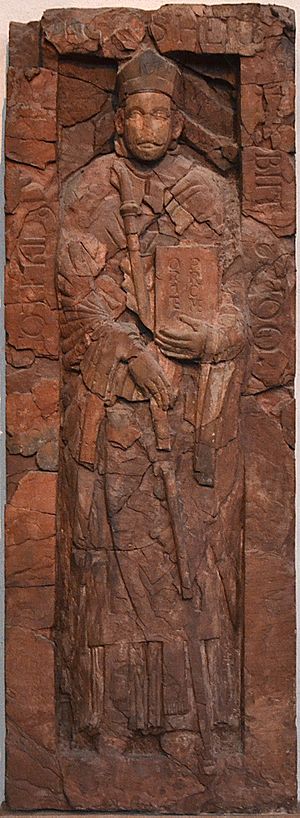Godfrey of Spitzenberg facts for kids
Godfrey of Spitzenberg (born 1132 – died July 8, 1190 in Antioch) was a very trusted advisor to Emperor Frederick I. He also served as a bishop in two important cities: Regensburg and Würzburg.
Contents
Who Was Godfrey of Spitzenberg?
Godfrey came from an important family. His father was Rudolf I of Sigmaringen. His family, the Sigmaringen-Spitzenberg family, was connected to powerful groups like the House of Helfenstein.
Godfrey's Education and Early Career
Godfrey was a very smart person. He studied law in Bologna, Italy, and theology (the study of religion) in Paris, France.
In 1172, he became a church official in Würzburg. He also started working for Emperor Frederick I as his imperial court chancellor. This meant he was a top advisor and manager for the emperor.
Helping the Emperor in Italy
Godfrey helped Emperor Frederick I in many ways. He joined the emperor's military trips to Italy. These trips were against a group called the Lombard League. Godfrey played a big part in making the Treaty of Venice in 1177. This treaty helped bring peace between the emperor and the Italian cities.
From 1184 to 1185, Godfrey was also a special representative for the emperor in Italy. He was very busy with these important jobs.
Becoming a Bishop
In 1185, Godfrey was chosen to be the bishop of Regensburg. A bishop is a high-ranking leader in the church. The next year, in 1186, he was chosen to be the bishop of Würzburg as well. After this, he left his work for the emperor to focus on his church duties.
The Third Crusade and Godfrey's Role
In 1187, a powerful Muslim leader named Saladin defeated the Christian armies in the Battle of Hattin. This led to the loss of Jerusalem, a very important holy city for Christians.
Calling for a New Crusade
Leaders from the Pope's office spoke at a big meeting in Strasbourg. They talked about how Jerusalem was lost and asked for it to be taken back.
On March 27, 1188, at another important meeting in Mainz, Godfrey gave a powerful speech. He encouraged people to join a new crusade. A crusade was a religious war to take back holy lands. Emperor Frederick I then asked everyone if he should lead this crusade.
Journey to the Holy Land
It was decided that a large army would gather in Regensburg the next year. Their goal was to travel to the Holy Land and take back Jerusalem. Godfrey joined this army.
The crusader army, led by Emperor Frederick I, traveled through the Balkans and then across Asia Minor. They faced many challenges and fought bravely.
Godfrey's Final Journey
Sadly, in 1190, Emperor Frederick I drowned in the Saleph River. After this, many crusaders in Antioch became sick. Godfrey also fell ill and died on July 8, 1190.
A Lost Hand
Before he died, Godfrey asked that his right hand be sent back to Würzburg. His hand was removed and sent on a journey. However, the people carrying it were likely attacked by robbers. The hand was lost and never made it to Würzburg. Today, only Godfrey's grave slab is in the Würzburg Cathedral.
Godfrey may have written an important letter about the emperor's death, called the Letter on the Death of the Emperor Frederick.


